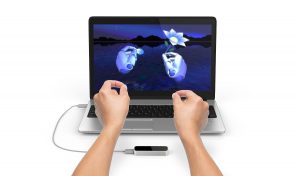Leap Motion is a hardware sensor that detects fingers movement and allows users to interact with a computer by waving their fingers and hands with no need for touch or the use of a mouse. It is significantly more accurate and less intrusive than other sensors like MS Kinect.
Leap Motion comes with a selection of over 160 applications, some of which show potential value for teaching and learning in the university.
The web-browsing feature is particularly interesting as it could be used in a wider variety of scenarios from training/lecture rooms to meeting rooms. It may also have the potential to be incorporated in labs, tills, field work scenarios, etc. to enable users operate hand free.
Further testing and development may be required to adapt Leap motion to specific contexts in the University, e.g.: accessibility scenarios.
Leap motion sensors are commercialised at a price of £69.99.

Findings and Recommendation
Leap is a new device in gesture control and a novel way to interact with the computer for end users. Applications are the key factors to drive the use of Leap. Defining the suitable application environment is the most critical factor.
Leap performs significantly accurately in hand tracking, although it still suffers from some glitches. The latest software update tracks not only the fingertips and palms of the hands but each joint as well which improves its stability.
Leap computer control apps provide a more intuitive way to perform some tasks like web and photo browsing, although the reliability and precision still need to improve and the users will need a fair amount of
self-training for better control of Leap.
Leap science apps may have potential to teach university subjects including biology, geology and medicine etc. They can provide a better user experience and an alternative solution for data visualisation.
